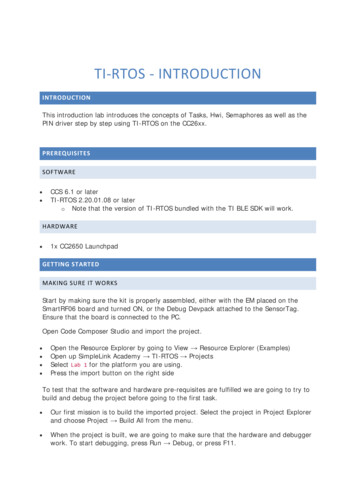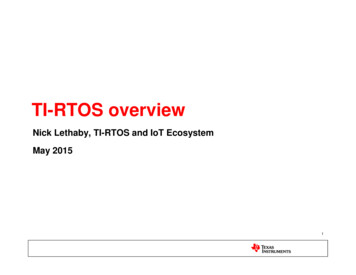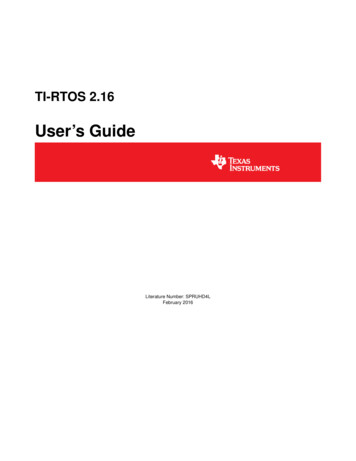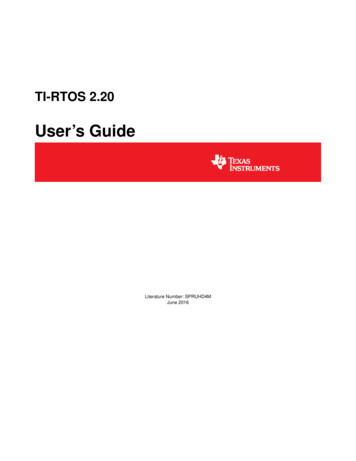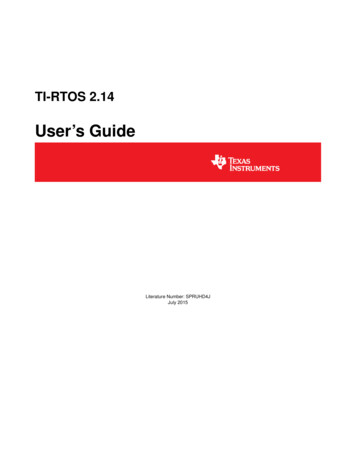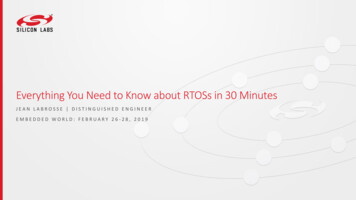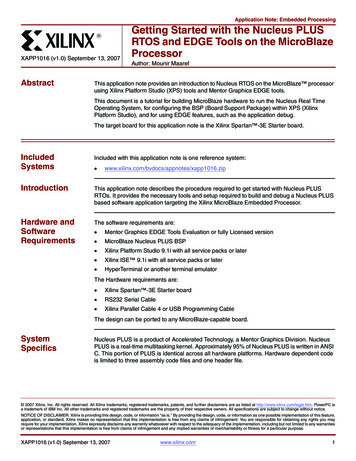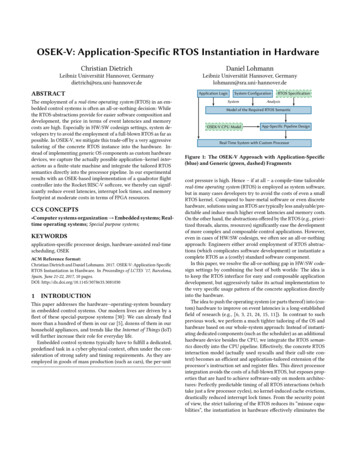
Transcription
OSEK-V: Application-Specific RTOS Instantiation in HardwareChristian DietrichDaniel LohmannLeibniz Universität Hannover, Germanydietrich@sra.uni-hannover.deLeibniz Universität Hannover, Germanylohmann@sra.uni-hannover.deABSTRACTThe employment of a real-time operating system (RTOS) in an embedded control systems is often an all-or-nothing decision: Whilethe RTOS-abstractions provide for easier software composition anddevelopment, the price in terms of event latencies and memorycosts are high. Especially in HW/SW codesign settings, system developers try to avoid the employment of a full-blown RTOS as far aspossible. In OSEK-V, we mitigate this trade-off by a very aggressivetailoring of the concrete RTOS instance into the hardware. Instead of implementing generic OS components as custom hardwaredevices, we capture the actually possible application–kernel interactions as a finite-state machine and integrate the tailored RTOSsemantics directly into the processor pipeline. In our experimentalresults with an OSEK-based implementation of a quadrotor flightcontroller into the Rocket/RISC-V softcore, we thereby can significantly reduce event latencies, interrupt lock times, and memoryfootprint at moderate costs in terms of FPGA resources.CCS CONCEPTS Computer systems organization Embedded systems; Realtime operating systems; Special purpose systems;KEYWORDSapplication-specific processor design, hardware-assisted real-timescheduling, OSEKACM Reference format:Christian Dietrich and Daniel Lohmann. 2017. OSEK-V: Application-SpecificRTOS Instantiation in Hardware. In Proceedings of LCTES ’17, Barcelona,Spain, June 21-22, 2017, 10 pages.DOI: TIONThis paper addresses the hardware–operating-system boundaryin embedded control systems. Our modern lives are driven by afleet of these special-purpose systems [30]: We can already findmore than a hundred of them in our car [5], dozens of them in ourhousehold appliances, and trends like the Internet of Things (IoT)will further increase their role for everyday life.Embedded control systems typically have to fulfill a dedicated,predefined task in a cyber-physical context, often under the consideration of strong safety and timing requirements. As they areemployed in goods of mass production (such as cars), the per-unitApplication LogicSystem ConfigurationSystemRTOS SpecificationAnalysisModel of the Required RTOS SemanticOSEK-V CPU ModelApp-Specific Pipeline DesignReal-Time System with Custom ProcessorFigure 1: The OSEK-V Approach with Application-Specific(blue) and Generic (green, dashed) Fragmentscost pressure is high. Hence – if at all – a compile-time tailorablereal-time operating system (RTOS) is employed as system software,but in many cases developers try to avoid the costs of even a smallRTOS kernel. Compared to bare-metal software or even discretehardware, solutions using an RTOS are typically less analyzable/predictable and induce much higher event latencies and memory costs.On the other hand, the abstractions offered by the RTOS (e.g., prioritized threads, alarms, resources) significantly ease the developmentof more complex and composable control applications. However,even in cases of HW/SW codesign, we often see an all-or-nothingapproach: Engineers either avoid employment of RTOS abstractions (which complicates software development) or instantiate acomplete RTOS as a (costly) standard software component.In this paper, we resolve the all-or-nothing gap in HW/SW codesign settings by combining the best of both worlds: The idea isto keep the RTOS interface for easy and composable applicationdevelopment, but aggressively tailor its actual implementation tothe very specific usage pattern of the concrete application directlyinto the hardware.The idea to push the operating system (or parts thereof) into (custom) hardware to improve on event latencies is a long-establishedfield of research (e.g., [6, 3, 21, 24, 15, 11]). In contrast to suchprevious work, we perform a much tighter tailoring of the OS andhardware based on our whole-system approach: Instead of instantiating dedicated components (such as the scheduler) as an additionalhardware device besides the CPU, we integrate the RTOS semantics directly into the CPU pipeline. Effectively, the concrete RTOSinteraction model (actually used syscalls and their call-site context) becomes an efficient and application-tailored extension of theprocessor’s instruction set and register files. This direct processorintegration avoids the costs of a full-blown RTOS, but exposes properties that are hard to achieve software-only on modern architectures: Perfectly predictable timing of all RTOS interactions (whichtake just a few processor cycles), no kernel-induced cache evictions,drastically reduced interrupt lock times. From the security pointof view, the strict tailoring of the RTOS reduces its “misuse capabilities”, the instantiation in hardware effectively eliminates the
possibility to inject code into the kernel domain. In combinationwith memory protection mechanisms (not addressed in this paper),perfect isolation without executing kernel code would be possible.In previous work, Dietrich et al. [9] have presented a staticcross-kernel and whole-system analysis, as well as an applicationspecific finite-state machine (FSM)-based kernel implementation [8].With this paper, we improve the efficiency of the system analysis,integrate the FSM-based representation into an actual processorpipeline, and employ further tailoring of system components thatbecome possible at the hardware level. In particular, we claim thefollowing contributions: We present a method to catch the semantics of a concrete RTOSinstance as a FSM to provide for an efficient hardware implementation. By application-specific instantiation of a standard RTOS interfaceinto the processor pipeline we achieve low syscall and interruptlatencies. The whole tailoring process is fully automated; hardware andsoftware variants are generated on demand. Our open-sourced implementation OSEK-V covers the automotive OSEK/AUTOSAR RTOS standards [23, 2] and integratestheir application-tailored semantics into the Rocket RISC-V core [17,34].The rest of the paper is organized as follows: Section 2 describesthe system model and gives an overview on our approach: Startingwith the application, a system state machine is derived in Section 3and integrated into the CPU pipeline in Section 4. We evaluate ourapproach in Section 5 on the example of a real-world flight-controlapplication, discuss the results in Section 6, and give an overviewon further related work in Section 7 before concluding in Section 8.2SYSTEM MODEL AND IDEAWe assume a static real-time control system with fixed-priorityscheduling: One application is combined with a statically configured RTOS (all threads and interrupt handlers are known/derivableat compile time) and delivered as a system image. We furthermoreassume a static application structure (no dynamic code loading,no invocation of syscalls via nontrivial function pointers). Notethat these requirements, while appearing harsh from the viewpointof general-purpose computing, are common practice and basicallyfulfilled inherently by the majority of real-time control systems:They are mandated by the dominant safety (e.g., MISRA-C [10],ISO 26262 [13]) and RTOS industry standards anyway. For instance,ARINC 653 partitions [1] (avionics), µITRON [28] and OSEK/AUTOSAR [23, 2] (automotive), but also the POSIX.4 real-time extensions (with SCHED FIFO) all prescribe fixed-priority scheduling ofa well-known set of tasks.2.1its internal state, and exposes the currently running thread as anoutput signal. Second, we integrate this SSM into an applicationspecific CPU design: the application triggers the SSM with newlyintroduced instructions and the pipeline reacts by dispatching toanother hardware thread. As the result, we get an automaticallytailored computing system for the concrete real-time application.Of course, in the general case such a RTOS-FSM would be intractable due to state explosion: The internal kernel state of anevent-triggered RTOS encompasses the ready list, thread contexts,the running thread, and so on. Every syscall is a potential point ofrescheduling at which, depending on the chosen scheduling strategy and the dynamic state of the ready list, some other thread maybe continued that, in turn, may trigger further syscalls.Still, our approach is tractable due to two facts: first, we relyon a system model with an inherently bounded number of possible system states. Second, we supply the system analysis withapplication-specific information to reduce indeterminism as faras possible at compile time: We exploit static knowledge aboutthe RTOS configuration and its semantics in combination with awhole-system analysis across all control flows of the application tofigure out how the RTOS is actually used. Thereby, we can reducethe number of possible states drastically, as the outcome of manyscheduling decisions can be derived (or at least constrained) aheadof time [9]. This, in turn, provides for an efficient implementationin hardware, where we integrate the RTOS and its tailored hardware components (e.g., thread contexts or timers) directly into theprocessor pipeline.Without loss of generality, we describe our approach in the following on the example of the system model mandated by OSEK. Ouractual implementation named OSEK-V covers OSEK/AUTOSARsystems [23, 2] up to conformance class ECC1.Our Approach In a NutshellFigure 1 visualizes our concept of usage-based tailoring of theRTOS down into the hardware: First, we perform an analysis ofthe specific application and its described system configuration toextract all possible interaction between application and RTOS asa finite-state machine. This system state machine (SSM) mimicsthe semantics of the RTOS for the concrete application; it receivesinput signals (synchronous system calls and interrupts), adapts2.2Overview of OSEK-OSThe OSEK standard defines a widely used class of fixed-priorityRTOSs and has been the dominant industry standard for automotiveapplications for the last two decades. Without loss of generality,we based our approach on the RTOS interface mandated by theOSEK-OS standard [23]. In the following, we briefly introduce theabstractions provided by its API.Basically, OSEK offers two main control-flow abstractions: interruptservice routines (ISRs) and tasks (traditionally called threads). ISRsare activated asynchronously by the hardware and have limited access to system services, while threads possess a statically assignedpriority and are activated synchronously by software. Threads areallowed to use all system services and are executed according toa fixed-priority preemptive scheduling policy. On each new activation, threads start from the very beginning until their (self-)termination.Critical sections can be synchronized either by a coarse-grainedglobal interrupt lock, or more fine-grained resource objects. Basedon a stack-based priority-ceiling protocol [4], OSEK resources ensure mutual exclusion while preventing deadlocks and unboundedpriority inversion. Furthermore, a thread can wait for an event tobe set and remains in the waiting state until another control flowsignals the arrival of the event.
app.cTASK(T) {TASK T {app.oilPRIORITY 10;kickoff();do computation();SCHEDULE FULL;};TerminateTask();}TASK(idle) {generated.cwhile(1) {idle();}COUNTER C {MAXALLOWEDVALUE 1000;};ALARM A {COUNTER C;}ACTION ACTIVATETASK {ISR(alarm tick) {};isr();increase counter(C);if (check alarm(C, A)) {ActivateTask(T);}TASK T;AUTOSTART TRUE {ALARMTIME 35;CYCLETIME 70;};};iret();}Figure 2: Example OSEK System. The system configuration(app.oil) describes a single thread T and its periodic activation every 70 ticks, which automatically begins at systemboot. The application code (app.c) includes the implementation of T and the generator materialized the system description into generated.cRecurring periodic as well as aperiodic thread activations orevents can be triggered with the help of statically declared alarms.Every alarm is connected to a counter, which typically is driventhrough a hardware timer. Alarms can be started with a phase/period automatically at system startup, or dynamically at run time.For a specific application, the developer declares all system objects and their parameters in a domain-specific configuration file.Typically, a system generator derives the concrete RTOS instancestatically at compile time and links application and OS library intoa single system image.In Figure 2, an example OSEK system with one task and oneperiodic alarm is shown. The application code (app.c) containsthe task T, which executes a computation and terminates itselfafterwards. The system configuration (app.oil) denotes that task Thas a static priority of 10, is fully preemptable (SCHEDULE FULL).Furthermore, a counter C is declared and connected to the alarm A,which expires every 70 ticks after an initial phase shift of 35 ticks.On expiration, the alarm A activates task T. During compile-time,the system generator produces a system harness (generated.c): Anidle task runs at the lowest priority; the alarm tick ISR handlermanages counters and alarms, when the timer interrupt occurs.In order to explicitly anchor system behavior, we added artificialsyscalls (idle, isr, iret, kickoff) to the code.In this work, we focus on the OSEK extended conformance class1 (ECC1), which includes waiting states and resources, but excludesmultiple tasks per priority and multiple activations per task. Subsequently, we consider the described RTOS primitives as a markuplanguage for expressing the real-time system (RTS)’s behavior, anduse the terms threads (for OSEK tasks) and ISRs to distinguishbetween the control-flows types.3SYSTEM STATE MACHINESince our approach is application-specific, we start with a systemanalysis on one specific RTS to extract an interaction model ofapplication, external environment and the RTOS. The system statemachine (SSM) captures the desired kernel behavior (i.e., rescheduling sequence) in the presence of the analyzed application and theenvironmental model. Dietrich et al. [9] described an applicationspecific state-transition graph (STG) that enumerates and connectsall possible system states. In this work, we improve the efficiencyof the STG calculation and subsequently derive the applicationspecific SSM from it.Within an event-triggered RTS, the RTOS receives signals fromtwo sides: the control application issues synchronous syscalls andexternal components deliver asynchronous hardware interrupts. Inboth cases, the RTOS is activated, manipulates its internal state, andmaterializes the scheduling result through dispatching. The internalsyscall issue ordering is restrained by the application logic; thepossible sequences of external events is shaped by the surroundingenvironment.3.1Application State MachinesFor the system analysis, we express the internal application-structureas a set of application-specific finite state machines; every threadand every ISR becomes an application state machine (ASM). Thesestate machines function as signal generators towards the operatingsystem model, which, in turn, orchestrates the execution of severalASMs. In previous work, Dietrich et al. [9] used a (condensed) CFGto express the syscall ordering. In contrast, the ASM representation is more dense and we achieve shorter analysis times due to areduced number of states.For each control flow, we calculate the ASM from the local CFG.1First, we partition the code into basic blocks that are not maximal,but do contain either a single syscall or only computation code;the later cannot influence the system state synchronously. Forthis separation of influences, we demand the application structure(CFG and syscall locations) to be known at system-generation time.Figure 3a shows the basic-block partition for the alarm isr handlerfrom Figure 2 (syscalls in dark red).In order to generate a state machine that produces a signal forevery executed basic block, we calculate the line graph from theCFG. Each CFG edge becomes a vertex, while each basic blockbecomes an edge labeled with the block’s contents. However, sincethe OS state can only be influenced through syscalls, we replace allcomputation by ε-transitions. It is noteworthy that the transitionlabels correspond to syscall sites and not syscall types. Figure 3bshows the line graph for the alarm tick ISR.We remove the ε-transitions by applying standard ε-eliminationto each ASM. Furthermore, we mark thread states that are reachablethrough a ε-transition as interruptible by an ISR (E) . For each ASMstate, the set of outgoing edges names those syscalls possible atone point in the application. Figure 3c depicts the three ASMsfor the running example: when the alarm handler is in state A2,ActivateTask and the iret syscall site can be executed next andsent to the SSM.1 The(thread-)local CFG connects all basic blocks reachable from the control-flowentry point. Function-call edges are included; the functions are virtually inlined.
ninatioisr();if(.)εεεiretTask(T)T1iret()(a) CFG for alarm tick ISRA2ActivateActivateTask(T)iretisrstartiret()(b) Initial Line GraphkickoffET2TerminateTask()A4T3rtA1increase .A3staisr()line graphiretateActiv T)(ksaTε -elimES1idlestart(c) ASMs: A1-4: alarm tick ISR; T1-3: thread T; S1: idle threadFigure 3: Application State Machines Construction for Example from Figure 2S1A3S1T1iretiretA1S1T2A3S1T2Figure 4: System State Machine. Every vertex is an abstractsystem state; transitions are triggered by syscalls. The currently running thread overlays the preempted threads. S:idle thread, A: alarm, T: thread.Currently, we use a very simplistic model to include other analysis results to restrict the external-event model. When a thread (ora group of threads) has an implicit deadline, the triggering eventis blocked until the event processing is finished [9]. Nevertheless,other logic of actions on application level could be derived and usedto restrict the event model. For example, it could be defined, that a“send buffer empty” interrupt could only occur after the associatedSendMessage() function had been invoked.The application model and the external-event model are connected to an abstract operating-system model. The OS model isinstantiated with the system configuration and adheres the OSEK semantics [23]. We use the system-state enumeration (SSE) [9] methodto combine all three parts and to explicitly enumerate all possiblesystem states in the STG.The STG is a directed graph of abstract system states (AbSSs),which capture a possible system state at one point in time andhold the information that can influence scheduling decisions. Particularly, each AbSS includes a vector of ASM states that indicatethe current preemption point of each control flow. In every state,exactly one flow is marked as the currently running thread. Fordetails on the STG construction we refer you to Dietrich et al. [9].Since every transition label in an ASM corresponds to an kernelactivation and the SSE only combines several ASMs according to thesystem semantic, the STG can directly be used a SSM. In Figure 4,the STG/SSM for the running example is given: The system startsfrom the idle loop. On an interrupt (E), the alarm handler canactivate thread T or directly return to idle. If activated, threadT is dispatched, executes the computation, and terminates itself.Although the alarm can expire again during the computation, thecan be activated only once.3.2System State Machine MinimizationThe resulting SSM already exposes the correct behavior, but thenumber of states and transition edges is not minimal yet. However,as state-machine minimization is a well covered and long standingtopic [22, 12], we will only investigate on the SSM specifics.For the SSM minimization, we meld all states that expose thesame observable behavior into a single state. In our case, the observable behavior is the sequence of possible re-scheduling events.For example, if two states always occur in the same sequence butdispatching happens only after the second one, the first state canbe merged into the last one. One instance of such a state pair arethe A1 and A2 states in our running example (Figure 4). From asystem perspective, all A1 states, which are activated by the hardware event (E), are followed by the same re-scheduling sequence asthe A2 states Therefore, the A1 state is subsumed by its respectiveA2 state. We identify such equivalent states by using the Moorealgorithm [22] and merge them into one state. If a transition labeloccurs only at self-loops after the merging, we can safely removethe signal completely from the system.3.3Static AlarmsOne benefit of our application-specific hardware tailoring is thepossibility for optimized components that match the static systemconfiguration. Besides the SSM, we also detect static alarms withinthe application, which are very common in embedded control systems: A static alarm starts automatically at boot time, is neverreconfigured, and triggers at a constant rate. We check for theseproperties by static analysis of configuration and application code.All non-static alarms are dynamic alarms and can, depending onthe configuration, be driven by a timer IRQ with a lower base rate,reducing the IRQ load.The alarm in the running example (Figure 2) is static: It startsautomatically at boot (AUTOSTART TRUE), has a phase of 35 ticksand a period of 70 ticks, and is never reconfigured.
hartexecutei-decodePChartregshartNPC Genn PCmem stagesyscallk signalsresultStatic AlarmsRTC Tickcurrent hartstore NPChartregister write backSystem StateMachineReg Filen 32 Regscommithartstallselect regsi-cachei-fetchselect NPCOSEK-V Specific ComponentsFigure 5: OSEK-V Pipeline4DERIVING THE OSEK-V PROCESSORIn the system analysis, we gathered information to tailor a parametrizable processor pipeline towards the application requirements. Wemap each OS thread to a hardware thread (harts) and introduce specialized instructions, which interact with the SSM component thatcontrols hart scheduling. Furthermore, a static-alarm componentgenerates periodic signals and activates the SSM asynchronously.4.1State Assignment and Logic MinimizationFor instantiating the SSM in hardware, we have to provide anefficient implementation of the state-transition function: Besidesthe current SSM state, it consumes one system event and returns anew system state together with the (next) hart.SSM : hsystem eventi hstatei 7 hstatei hhartiThe system analysis produces a SSM with symbolic signals(e.g.“TerminateTask”, “ActivateTask(T)”) and states. For a hardware implementation, we have to choose bit vectors for these symbolic values (e.g., hActivateT ask(T )i 1012 ). This choice, knownas the state-assignment problem, largely influences the minimalrequired complexity of the hardware implementation. Luckily, several methods have been proposed to solve this problem for differenthardware designs [33, 7, 32].We use the NOVA program [33] to solve our state-assignmentproblem. NOVA targets optimal encoding for two-level logic implementations and chooses bit vectors for the system calls and the SSMstates accordingly, when given a “thread id” encoding, which wechoose arbitrarily. Since NOVA internally uses a logic minimizer,we get a minimized truth table for the transition function as a result.With this truth table, and the static-alarm information, we proceedto instantiate the OSEK-V processor.4.2The OSEK-V ProcessorWe built OSEK-V on top of the Rocket core [17], a 64 bit, 6-stage,in-order pipeline. While this soft core is not primarily targeted forembedded systems, a compatible stripped-down 32 bit variant is currently developed. The Rocket implements the RISC-V interface [34],an ISA designed to support computer-architecture research. TheRocket resembles a hardware product family and exposes a multitude of configuration switches to adapt the implementation towardsapplication requirements.We have integrated OSEK-V into the Rocket chip generator,which is able to generate a cycle accurate C simulator at theregister-transfer level. With our adaptions, it instantiates all components according to the results of the system analysis and wiresthem up into the pipeline (see Figure 5).In order to provide fast control-flow switching, we have extendedthe pipeline to support hardware threading. The processor is enabled to track different execution flows (harts) and their contextssimultaneously: Each pipeline stage has a tag to hold informationabout the currently executed hart; register file and program-countergenerator (NPC Gen) are extended to hold the execution contextfor multiple hardware threads (harts). The issuing of instructionsfrom different harts is controlled by the SSM.In our current implementation, every OSEK task and the idlethread is mapped as separate harts, while ISRs still execute in thecontext of the current hart. This is a trade-off between ISR activation times and hardware resource consumption, but could besoftened by using one dedicated hart to execute all ISRs.4.3Special Instructions and Static AlarmsFurthermore, the OSEK-V pipeline provides two new instructions tointeract with the SSM: ssm.ld and ssm.tx. The ssm.tx instructionis used in the boot code to set the instruction pointers for all harts.The ssm.tx instruction communicates its immediate operand as asystem event (see Section 4.1) to the SSM, which, in turn, invokesthe state-transition function on it.When an ssm.tx instruction enters the pipeline and reaches theexecution stage, the preceding stages are stalled until memory andcommit stage have emptied. This stall ensures that all exceptionspreceding the ssm.tx instruction remain precise. The execute stagesends the system event to the SSM. While the SSM applies the transition function and updates the “current hart” signal, the pipelineis stalled. If a re-schedule happens, the branch-mispredict logic isreused to flush the pipeline and to issue an instruction fetch for thenew hart’s program counter.Besides the ssm.tx instruction, the static-alarm component alsoissues system events. Internally, it derives clock signals with different phases and periods from the real-time–clock tick and communicates with the SSM. If one or more alarms expire, the static-alarmcomponent pauses the pipeline and waits for the current instructions to finish. Afterwards, multiple system events are transmittedatomically to ensure that alarms can trigger simultaneously. Thetransmission is initiated with one hisr ()i, multiple alarm actions(e.g., hActivateT ask( )i) build the body, and the hiret()i triggers apossible rescheduling.
Static-alarm events are handled like other external events; theyare only accepted when interrupts are currently not locked in theprocessor. Therefore, all regions with locked interrupts still have arun-to-completion semantic.The OSEK-V functionality is incorporated into the Rocket chipgenerator; configuration parameters are encoded as JSON and directly read and interpreted by the hardware design. The parametersinclude the minimized truth table of the SSM logic, the number ofharts, and the static-alarm setup. While the configuration statesonly the intentional behavior, the generator decides how implementthese requirements. For example, the static-alarm component usesdifferent strategies to derive clock signals depending on the phaseand period of the alarm activation.4.4System Generation and StartupTailored hardware also requires the system software to be tailored.By pushing the OS logic in hardware, only little functionality is leftto the software part of the kernel. At boot, the kernel configures theprogram counters with the ssm.ld instruction. The stack pointeris initialized by the thread itself as one of the first instructions.When a terminated thread is reactivated, it starts executing atthe stack–setup code. The remaining dynamic alarms, as well asregular interrupts are handled by the software kernel. Withinthe application, syscall sites are replaced with ssm.tx instructionscarrying system-event identifiers. The syscall sites have to beenclosed by a pair of interrupt disable/enable commands, to ensuresymmetry between the re-schedule points in ISRs and threads.We made the process of tailoring the RTOS and the hardwarefully automated. The system analysis and transformation is implemented in the dOSEK framework and requires no manual intervention. The Rocket generator reads in the processor configuration andgenerates the OSEK-V instance; either as cycle-accurate emulatoror as Verilog code.5EXPERIMENTAL RESULTSFor our evaluation scenario, we employ the I4Copter [31], a safetycritical embedded control system (quadrotor helicopter) developedin cooperation with Siemens Corporate Technology.We analyzed the task setup of the I4Copter control application(Figure 6): Threads are activated both periodically and sporadicallyby three alarms and one ISR. Inter-thread synchronization is realized with OSEK resources and a watchdog thread observes theremote control communication. In total, the scenario consists ofeleven threads, three periodic events (alarms), one sporadic interrupt, and one resource. One alarm, which controls the watchdogthread and runs with a low activation rate, is reconfigured at runtime, and, therefore, is a dynamic alarm; the two others are static.We replaced the application logic with checkpoint markers, sincewe are interested in the interaction between application and kernel.The substitution does not influence the analysis, but only exchangesthe contents of computation blocks. In total, the system includes52 system-call sites.During the SSM construction (Section 3), we used applicationknowledge about implicit d
on a system model with an inherently bounded number of pos-sible system states. Second, we supply the system analysis with application-speci c information to reduce indeterminism as far as possible at compile time: We exploit static knowledge about the RTOS con guration and its semantics in combination with a
